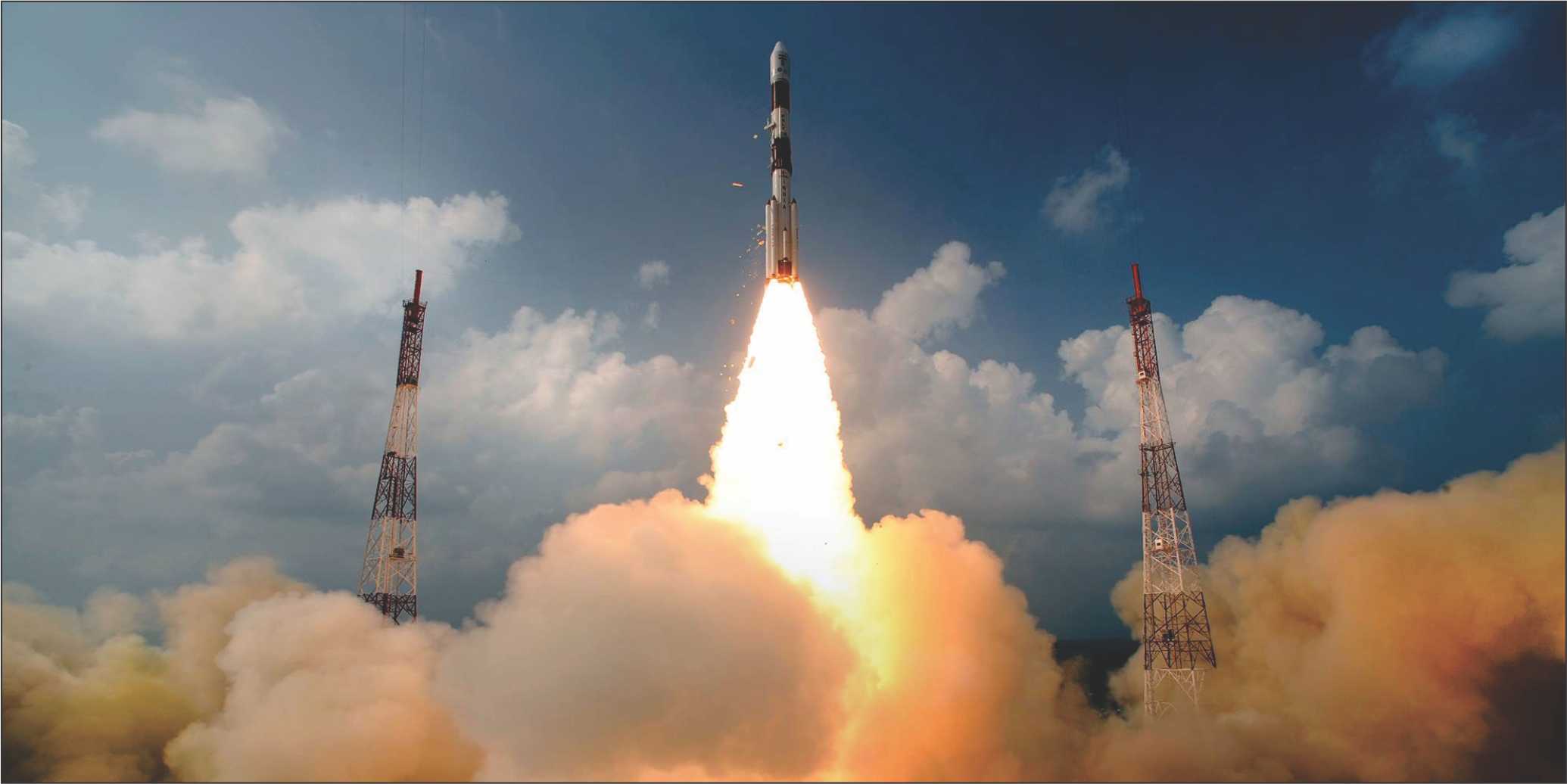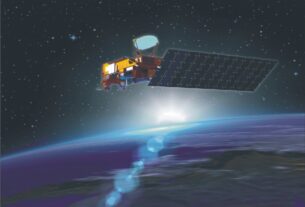India has created a splendid space history with the Indian Space Research Organisation (ISRO) successfully inserting the Rs 4500-million Indian Mars Orbiter spacecraft into its final orbit around the Red Planet on the morning of September 24th, 2014. It was indeed a space dream come true for India.
With this spectacular achievement, India pulled off the distinction of becoming the first country in the world to successfully nudge the Mars spacecraft into its final orbit in the very first attempt itself. This has also made India the first country in Asia to reach Martian orbit without any hitches.
Indian Prime Minister Narendra Modi who was in Bangalore to witness the Mars Orbiter insertion mission said, “With today’s spectacular success, ISRO joins an elite group of three space agencies worldwide to have successfully reached the Red Planet.”
Indeed, the success in inserting the Mars Orbiter spacecraft into its final orbit around the Mars has made India the fourth space power after the US, Russia and Europe to orbit or land on the Red Planet.
No doubt, with its astounding success, Indian Mars Orbiter probe Mangalyaan stands out as a vibrant symbol of India’s growing prowess in the frontier area of space exploration. Responding to the successful insertion of Mangalyaan into its pre-designated orbit, China said that the mission was a “pride of Asia”. A spokesperson of China Foreign Affairs Ministry said, “We congratulate India on Mars satellite entering orbit successfully”.
Successful first attempt
Of the 51 Mars probes launched by the advanced space faring nations so far, only 21 are known to have succeeded. Interestingly, the European, the US and Russian probes managed to orbit or land on the Red Planet only after initial flops and repeated attempts. With the successful insertion of the Indian Mars probe into its final orbit, the focus would now shift to the scientific experiments, the most exciting of which will be the efforts to detect the presence of methane on Mars. In all, there are five payloads on-board the Indian Mars spacecraft; the data from these scientific instruments will help space scientists get an insight into the early history and evolution of the Red Planet.
The exercise of inserting Indian Mars Orbiter Mission Mangalyaan into its final orbit around the Red Planet was carried out from the Missions Operations Complex of the Tracking, Command Control Centre of the Indian Space Research Organisation (ISRO), Bangalore.
The complex insertion exercise took off with the spacecraft change over to Medium Gain Antenna followed by a series of orbiter insertion steps and ultimately the reverse manoeuvre culminated in the insertion of the spacecraft into its final orbit around the Red Planet. Incidentally, the entire exercise was made possible by the firing of the on-board Liquid Apogee Motor (LAM) for duration of 24 minutes. The 440-Newton LAM sizzled with life as it burnt brightly in tandem with thrusters to help Mars Orbiter mission spacecraft to be captured by the Red Planet. The LAM firing had brought down the velocity of the Mars spacecraft to 4.4-km from 22.1-km. This helped in getting probe’s trajectory right and facilitated its entry into the Mars’ orbit. The spacecraft had entered Martian neighbourhood on September 22, 2014.
The home-grown LAM, which was fired for seven times to propel the spacecraft beyond the influence of earth’s gravitational field, was originally designed and developed by ISRO for its communications satellites. As it is, LAM which had remained inactive after the spacecraft was on course to Mars , it was fired for about four seconds on September 22nd to check whether it is in operational trim for the final mission of sending Mars spacecraft into orbit around the Red Planet. Interestingly, the Trans Mars injection operations of the probe were carried out successfully on December 1, 2013 and following this the orbiter was put on the Mars transfer trajectory.
For the Indian space programme, the successful accomplishment of the Mars mission marks a paradigm shift thereby signalling that India is well equipped to handle complex and challenging interplanetary missions. While looking back at this tricky exercise of nudging the Mars spacecraft into the orbit around Red Planet, it becomes very clear that it was a risky, make or break exercise. For even a slight slip on the part of the ground based operators at the ISRO Tracking, Control and Command Centre in Bangalore would have sent the spacecraft tumbling down into the depths of the space. Interestingly, interplanetary missions forms a part of India’s Space Vision 2025.
Technological competence
The Indian Mars Orbiter spacecraft had covered a distanced of more than 650-million kms spread over a period of 300 days to reach its final orbit. Managlayaan, considered the cheapest ever ticket to the Red Planet, will help provide India the necessary level of technological competence required to undertake more challenging interplanetary missions of the future. According to ISRO, the orbiter will keep moving in an elliptical orbit for about six months and its five scientific instruments will be busy collecting data.
The Indian Mars Orbiter Mission (MOM) with a lift off weight of 1340-kgwas launched in November 2013 by means of an augmented version of the four stage Polar Satellite Launch Vehicle (PSLV). This was India’s first interplanetary mission and was considered a logical follow onto the success India pulled off with the maiden lunar mission Chandrayaan-1 launched in October 2008.
In the context of the changed political environment in the country, India considers interplanetary missions such as Mangalyaan as the vital ingredients of its quest to sustain the leadership position in space exploration. The probe was launched into an elliptical earth parking orbit with a perigee of 248.4-km and an apogee of 23,550-km inclined at an angle of 19.27 degree to the equator.
Significantly, the total weight of the scientific instruments lofted by the Indian Mars orbiter is around 15 kg. The heaviest payload onboard the spacecraft weighing 3.56 –kg is the MENCA.
Scientifically the most significant experiment that the Indian Mars spacecraft will carry out is looking for the signs of methane in the Martian atmosphere through the Methane Sensor for Mars (MSM). Each of these payloads has measuring techniques but the MSM is very important which will tell about the possibility of life having existed on Mars. The Thermal Infrared Imaging Spectrometer (TIS) will measure the thermal emissions and can be operated both during day and night. It will map the surface composition and conduct mineralogical studies of the Red Planet. In the ultimate analysis, the Indian Mars probe is expected to help generate the first ever comprehensive map of the Red Planet.
This first ever Indian inter planetary mission is being envisaged as a stepping stone for India’s deeper forays into outer space in the years ahead in keeping with India’s ambition of emerging as a technological power house of global standing. By all means, Mangalyaan is the most complex and challenging space mission ever tried out by the Indian space agency.
The scientific objectives of Mangalyaan include the study of the Martian surface features, morphology, mineralogy and Martian atmosphere with the following payloads:
• Mars Colour Camera(MCC) for optical imaging
• Thermal Infrared Imaging Spectrometer (TIS) to study surface composition and mineralogy
• Methane Sensor for Mars(MSM) to detect the presence of Methane
• Mars Exospheric Neutral Composition Analyser(MENCA)to study the neutral composition of
Martian Upper Atmosphere
• Lyman Alpha Photometer(LAP) to detect D/H ratio in order to study escape processes of Martian
atmosphere
According to Dr V Adimurthy, who headed the study team on Indian Mars mission, the failure rate of Mars missions was substantial amounting to almost 50%.The team had analysed the results of the past missions undertaken by various countries including the US and Russia. “Communication with the satellite and tracking it poses problems. So we had to have on-board autonomous control system,” says Adimurthy. It is not for nothing that ISRO researchers had carefully studied the failures and success of various missions to Mars before arriving at the spacecraft configuration and mission profile. Indian Mars Orbiter mission provides India with an opportunity to test technologies like spacecraft autonomy, long distance space communications, interplanetary navigation and miniaturized space payloads and systems.
Incidentally, the technologies developed for the Mars mission will stand ISRO in good stead while building probes to Venus and inner asteroid belt in the years ahead. On another front, the Indian Mars mission has all the potentials to fire scientific imagination of the young Indian minds keen on pursuing frontier research that could also result in the development of cutting edge technologies that no country is willing to sell or share.
The cost of Mangalyaan is said to be one tenth of what USA has spent on its MAVEN (Mars Atmosphere and Violet Explorer). Remarkably, ISRO has spent a mere US$75-million on the Mangalyaan mission, an astoundingly small budget for a project so complex.
Leadership position
A section of Western analysts have also projected the view that Indian Mars mission is a symbol of India’s overriding ambition to attain super power status. But then, India, like other space faring countries, has every right to project its prowess in outer space in a peaceful manner. To work towards attaining the status of a super power is a prerogative of a sovereign, independent country. Moreover India which lost the “Industrial Revolution” as a nation under foreign rule, could not afford to remain silent in so far as the exploration of the final frontiers is concerned. Indeed, an interplanetary probe like Mangalyaan is vital to affirm India’s leadership position in outer space.
It was during the 2012 Independence Day address to the nation that the former Prime Minister Manmohan Singh had made an announcement of the Indian Mars mission stating that it would be huge step forward for the country in the area of science and technology. Against this backdrop, there has been a speculation that India’s Mars probe could be a well calculated strategic exercise to turn India into Asian pioneer in so far as the exploration of the Red Planet is considered.
Indeed, from the Asian perspective success had eluded Martian probes sent both by China and Japan. It may be recalled that a Chinese probe formed a part of the doomed Russian Phobos Grunt mission launched in 2011 to one of the moons of Mars. Similarly, a Japanese Martian probe launched in 1998 had come a cropper on account of a mechanical hitch on board the spacecraft. As it is, India’s Mars probe not only showcases the technological prowess and scientific acumen of the country but also highlights the cost efficient, frugal engineering skill for which India has a reputation.
According to ISRO Chairman K Radhakrishnan, Mars mission is a “historical necessity, since after having helped find water on the moon, looking for signatures of life on Mars is natural progression. The successful accomplishment of this mission not only marks a major milestone for the Indian space, but also provides India with a springboard for future international deep space missions not only to Mars but to other planets of the solar system. This planetary mission has implications for improved science, technology and risk management involved in long distance planetary missions. Mars holds great potential and relevance to earthlings because in about 500 years from now humans might be able to use Mars as resources base for earthlings. Former Indian President and internationally recognised space scientist Dr APJ Abdul Kalam has made an impassioned plea for a well organised international collaboration to give a practical shape to the human dream of colonizing Mars. It is widely perceived that Mars could be the next outpost of human civilization in our solar system. But then the grim ground reality is that man is still many years away from sending a human expedition to the Red Planet.
The view of the Indian scientific community is that Indian Mars probe will be in a position to look at Mars in a totally different perspective. As it is, data provided by the American Curiosity rover has not been able to establish the presence of methane on Mars. Interestingly, about a decade back, planetary researchers began to report finding methane in Mars atmosphere using data from both ground based instruments and space based missions.
Detecting methane
However, as is the case with earth, methane can also be generated by geochemical processes in which hot rocks interact with water and carbon dioxide. However, many scientists are sceptical about the existence of methane on the Red Planet.
Not surprisingly Indian Mars mission has excited global interest given that it has a scientific instrument designed to detect the presence of methane in the Martian atmosphere. As India’s Chandrayaan-1 made research history with the discovery of water in the moon, Mangalyaan too can come with something new about the red Planet, many aspects of which continue to remain shrouded in mystery.
According to NASA (National Aeronautics and Space Administration),” The formation and evolution of Mars is comparable to earth, helping us learn more about our own planet’s history and future. Mars had conditions suitable to life in its past. Future exploration could uncover evidence of life, answering one of the fundamental mysteries one of the fundamental mysteries of cosmos: Does life exist beyond earth”?
Earth and Mars have many things in common. For long, space researchers have been curious to know whether Mars did ever harbour primitive life forms millions of years ago and what happened to it now depleted atmosphere. If India had missed the opportunity of launching Mangalyaan in November 2013, the next chance could have come only in 2018. Ultimately, it was a race against the time that proved a grand success.





